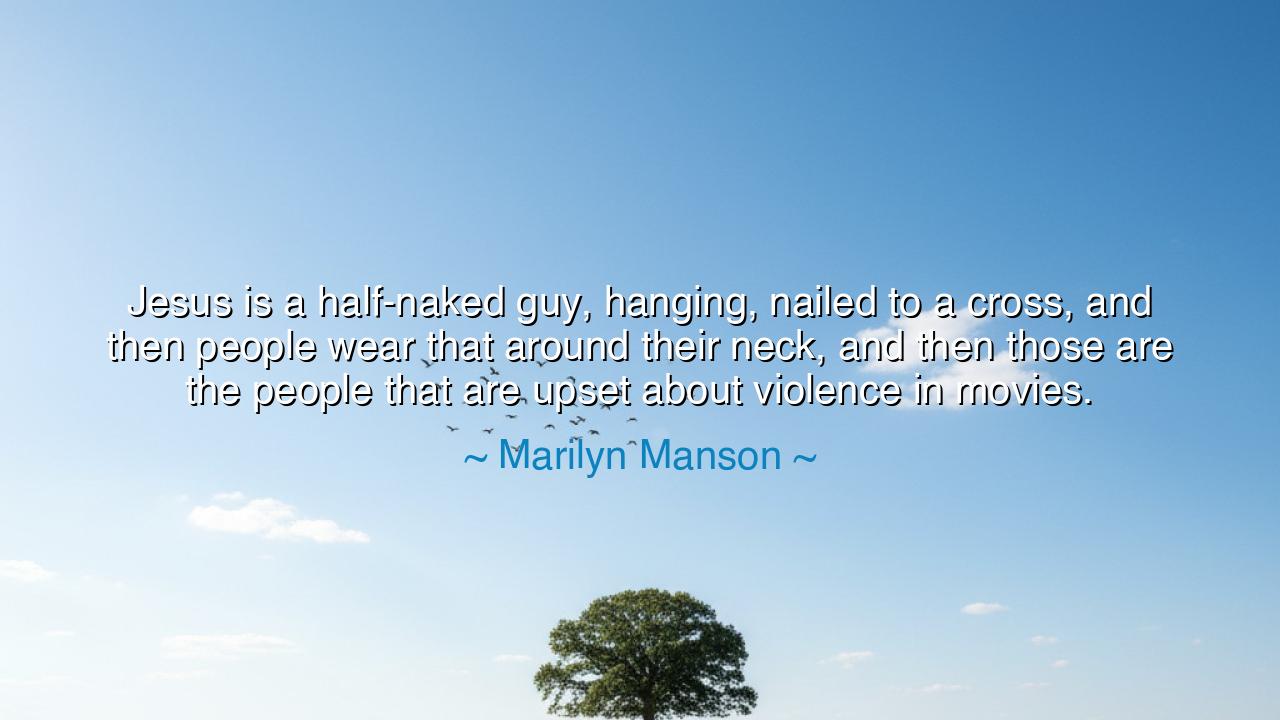
Jesus is a half-naked guy, hanging, nailed to a cross, and then
Jesus is a half-naked guy, hanging, nailed to a cross, and then people wear that around their neck, and then those are the people that are upset about violence in movies.






Listen closely, O seekers of wisdom, for the words of Marilyn Manson offer a daring reflection on hypocrisy, violence, and the contradictions inherent in human belief systems. He spoke thus: “Jesus is a half-naked guy, hanging, nailed to a cross, and then people wear that around their neck, and then those are the people that are upset about violence in movies.” In these words, Manson challenges us to confront the inconsistencies between the symbols we venerate and the actions we take. He points out that the very image of Jesus, the suffering figure on the cross, a symbol of sacrifice and violence, is worn by many who claim to be repulsed by the violence depicted in films or in the world around them. This irony, he suggests, speaks to a deeper conflict within society and within ourselves.
In the ancient world, symbols were not just representations—they were deeply sacred, holding within them the essence of the gods, the forces of nature, or the ideals of a civilization. The crucifixion of Jesus, for example, was not just a moment of death; it was a moment that transcended history and time, becoming a symbol of suffering, redemption, and divine love. Yet Manson’s words force us to consider this contradiction: the symbol of Jesus, one who died in agony and violence, has been turned into a symbol of peace and love, worn on necklaces and in homes, but often by those who ignore the deeper meaning of his suffering. Manson’s point is a reflection on how symbols are commodified—stripped of their power, reduced to a mere fashion statement, while the violence they originally represented is often ignored or even embraced in other contexts.
Consider the story of the ancient Greek gods, who were worshipped not only for their power but for their flaws and struggles. Zeus, the king of the gods, was a figure of immense power, but he was also deeply flawed—he committed acts of violence, betrayal, and even deception. Yet, the people revered him. They did not see the violence as a contradiction; instead, they saw the gods’ flaws as part of their nature, a part of the greater cosmic struggle. The gods, with their power and violence, became symbols of the human condition—a reflection of the balance between light and dark, creation and destruction. In this way, Manson’s critique is echoed in the ancient world: symbols of power and violence often go hand in hand with the sacred and revered, and yet we are quick to ignore the full scope of their meaning.
Consider the Roman gladiators, whose battles to the death were viewed as entertainment by the masses. The Colosseum was a place where violence was both worshipped and feared, where the human capacity for suffering and spectacle was put on display. The people cheered for death, even as they revered the idea of peace and virtue in their rulers. The Romans, like many cultures before and after them, understood that violence was both a tool of power and a part of the human experience, but they also compartmentalized it, often separating their idealized values from their real, violent acts. Manson points to this separation of ideals from actions, showing how people often live in contradiction, embracing symbols of peace while ignoring or indulging in violence.
Manson’s words also invite us to reflect on the evolution of our symbols. Jesus, once a revolutionary figure who challenged the oppressive systems of his time, was crucified for his defiance—a violent act meant to silence him. Yet, over time, his image has been transformed—the cross now stands as a symbol of salvation and hope, largely divorced from the brutal reality of its original meaning. This transformation of symbols can be seen throughout history, where the suffering and struggle they represent are often sanitized to fit the needs of those who wish to wear them as emblems of virtue rather than recognizing the true struggles and violence they embody.
So, O children of the future, take this lesson to heart: Understand the power of symbols, but also understand their true meaning. Do not allow symbols of suffering or power to become commodified or detached from their deeper significance. Just as Jesus on the cross is both a symbol of love and violence, so too are the symbols in our lives often complex, containing both light and shadow. We must be aware of these contradictions and seek to live in harmony with the deeper truths they represent, rather than using them as tools for convenience or superficial morality.
And so, let us live with the awareness that symbols are not mere objects—they carry the weight of history, suffering, and transformation. Let us approach them with respect, understanding that the violence and peace they represent are not separate, but interwoven into the very fabric of the human experience. In doing so, we will come to a deeper understanding of our own contradictions and the wisdom that can only be found by embracing both the light and the dark within us.






AAdministratorAdministrator
Welcome, honored guests. Please leave a comment, we will respond soon